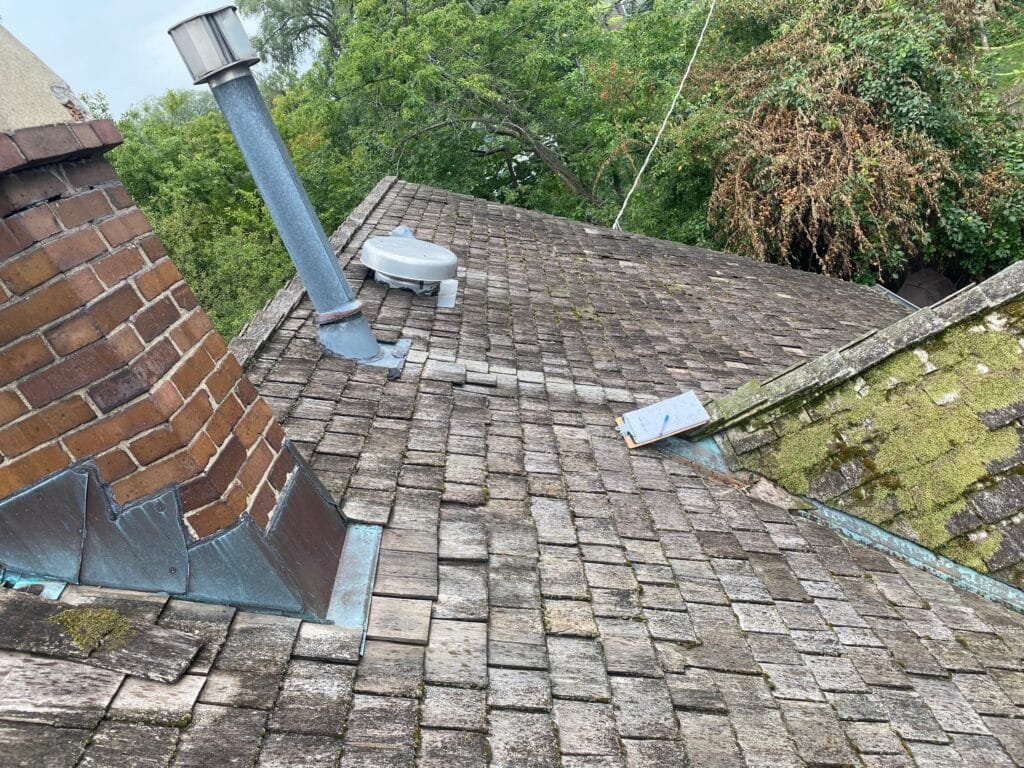Cedar, known for its durability and natural beauty, has been one of the most popular roofing materials in Illinois for ages. Good mechanical properties, water and UV resistance and constant availability due to the location made it widely known and loved both by roofers and homeowners. However, not every cedar tree is appropriate for construction purposes, and if it is, it may not be the best choice. But what are the differences? What kind of cedar is used in roofing industry and why?
Table of Contents
Why Do We Use Cedar as a Roofing Material?

We recently wrote an article about why is cedar a good roofing material, so if you want to explore this topic more, please read our previous post. For the moment, let’s note that:
- Cedar is chosen mainly for its appearance – it is a very noble and aesthetically pleasing wood, which even after many years still retains its beauty, and if properly maintained, fading can be avoided;
- Unlike synthetic roofing materials and asphalt shingles, wood is environmentally friendly, both at the production and subsequent disposal stages, which is becoming an increasingly important aspect for many homeowners;
- Natural cedar has good insulating properties due to its porous structure, which translates into lower temperatures in summer and higher temperatures in winter;
- Wood is one of the oldest materials in roofing, and its current popularity is partly the result of tradition and habit.
You may like it too: How to remove a moss from your roof?
Why Not Every Kind of Cedar is Suitable for Roofing?

At the very outset, we found that not every species of cedar performs equally well in roofing (or in general, in the construction industry). Although, as a general rule, each type of this wood has very good mechanical properties, due in part to the slow growth process of the trees and the high concentration of resin, the differences can be visible to the naked eye.
Some species, such as incense and inland red cedar, are characterized by a lower content of etheric oils and resin – not a desirable phenomenon, since roofs made from these types of wood are less resistant to rot and pests. Because of their more attractive price, they are used, for example, for making small garden architecture or furniture.
Other types, such as southern red and spanish cedar, have a lower density due to their faster growth rate. In the roofing industry, this is not desirable, because although such wood provides better insulating properties, the overall resistance of shakes is lower.
Given that cedar shakes are not a budget product, basically no one chooses to buy intermediate solutions. When ordering such a roof, our customers care about the highest possible quality and durability, so their gaze is directed to…
Best Species of Cedar for Roofing Purposes

By far the most widely used species is western red cedar. This beautiful, characteristically brown wood dominates the roofing market in Illinois, mainly because of the frequency of trees of this species.

Slightly less popular is the eastern red cedar, which has a slightly lighter color and more visible grains compared to western red cedar. In practice, the differences in wood strength are small, and prices are similar. It is the material we use for roof installation in Winnetka and the surrounding area. We can even say, that as the best cedar roofing contractor company in Chicago, we wouldn’t have taken the risk by choosing a different type of wood.
Compared to other cedar species, eastern red cedar (Juniperus virginiana), stands out above all for its above-average level of resistance to decay and insects. The less intense color is something worth sacrificing in the name of much better technical performance, and by making eastern cedar a species native to Illinois, the cost of purchasing such shakes is significantly lower.

The podium is rounded off by Alaskan yellow cedar, which has much better parameters – it is harder, denser and more compact, which on the one hand results in longevity and weather resistance of the wood, but on the other hand, translates into much more difficult processing and higher price. In practice, no roofs are made of this material in Illinois, as it is difficult to find local distributors who have the material.
How do You Check if Particular Batch of Wood is Sufficient for Roofing?

Before we start replacing your roof, we need to get wood with the best possible performance. Otherwise, the shakes may not be suitable for further use after a few years, and we would have to make repairs under the warranty, which lasts 20 years. We care about your satisfaction, so we pay attention to several parameters each time we manufacture shakes:
- Humidity – it should stay between 10% and 14% – higher humidity combined with inadequate roof ventilation can lead to mold growth;
- Color – shakes should stay brown, but their tones may vary form pale to dark-reddish brown;
- Thickness – The shakes can be 1/2″, 5/8″ or 3/4″ thick, but it is very important that their dimensions are constant;
- Marks of pest existence or rot – sometimes it happens that shakes have been infested by parasites or rot. If this has occurred, the piece in question absolutely must not be on your roof, as the infection can spread to a larger area.
Contrary to appearances, the biggest problem arises when choosing the right color of shakes, because within a single cedar tree trunk, there are large discrepancies in shades. In order to maintain proper aesthetics, there is nothing left to do but choose the right pieces.
You should read it: Is roof replacement worth it?
What Happens if I Use Low-Quality Cedar Shakes?

Well, at the very beginning, you will not notice any problems. After 2-3 years, fading may occur – cedar shakes with a lower concentration of resin and oils will be less resistant to UV light and water. Over time, the situation will get even worse – shakes may twist and warp, along with regular soaking and drying out. Finally, weaker-quality cedar roofing will be noticeably less resistant to hail – as evidenced by the UL-2218 standards, and it’s worth looking for a roofing contractor that offers shakes of Class 4, the highest grade.
There are no cedar shakes that are indestructible. The phenomena described in the previous paragraph will affect absolutely any wooden roof, but if you choose a top-quality product, the damage will simply begin to occur later, and consequently, the intervals between roof replacements will lengthen. It is not worth saving on either the service provider or the material used, as shakes that are 20%-30% more expensive will last much, much longer.


